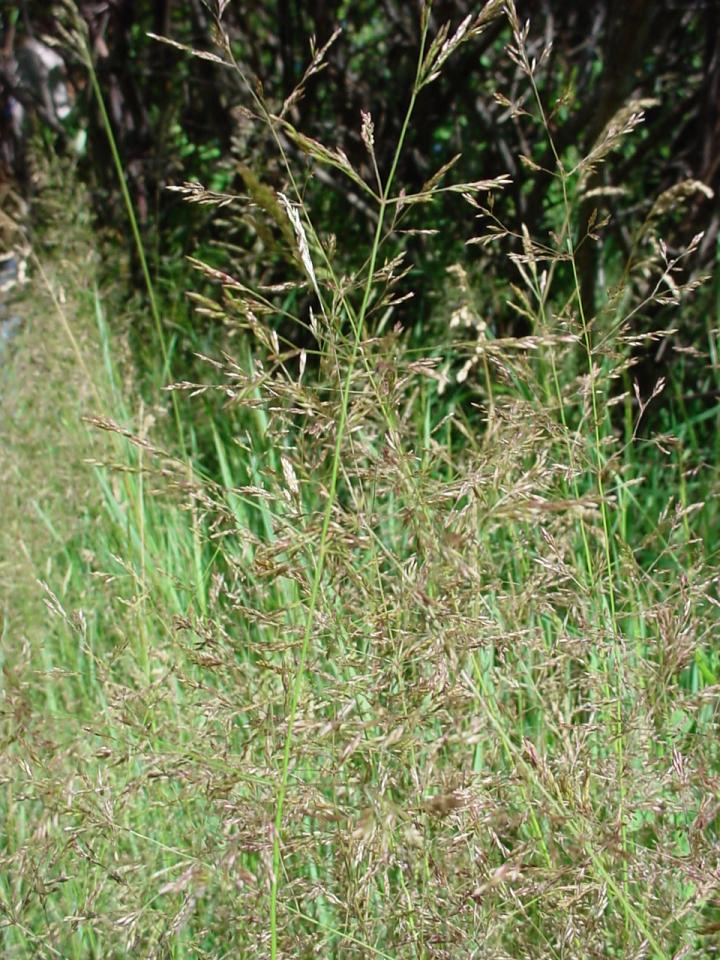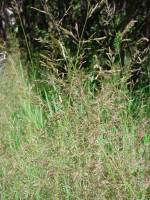Perennials, Terrestrial, not aquatic, Stolons or runners present, Stems nodes swollen or brittle, Stems erect or ascending, Stems geniculate, decumbent, or lax, sometimes rooting at nodes, Stems caespitose, tufted, or clustered, Stems terete, round in cross section, or polygonal, Stem internodes hollow, Stems with inflorescence less than 1 m tall, Stems, culms, or scapes exceeding basal leaves, Leaves mostly basal, below middle of stem, Leaves conspicuously 2-ranked, distichous, Leaves sheathing at base, Leaf sheath mostly open, or loose, Leaf sheath smooth, glabrous, Leaf sheath and blade differentiated, Leaf blades linear, Leaf blades very narrow or filiform, less than 2 mm wide, Leaf blades 2-10 mm wide, Leaf blades mostly flat, Leaf blade margins folded, involute, or conduplicate, L eaf blades mostly glabrous, Ligule present, Ligule an unfringed eciliate membrane, Inflorescence terminal, Inflorescence an open panicle, openly paniculate, branches spreading, Inflorescence a contracted panicle, narrowly paniculate, branches appressed or ascending, Inflorescence solitary, with 1 spike, fascicle, glomerule, head, or cluster per stem or culm, Inflorescence branches more than 10 to numerous, Lower panicle branches whorled, Flowers bisexual, Spikelets laterally compressed, Spikelet less than 3 mm wide, Spikelets with 1 fertile floret, Spikelets solitary at rachis nodes, Spikelets all alike and fertille, Spikelets bisexual, Spikelets disarticulating above the glumes, glumes persistent, Spikelets disarticulating beneath or between the florets, Rachilla or pedicel glabrous, Glumes present, empty bracts, Glumes 2 clearly present, Glumes equal or subequal, Glumes equal to or longer than adjacent lemma, Glume equal to or longer than spikelet, Glumes 1 nerved, Lemmas thin, chartaceous, hyaline, cartilaginous, or membranous, Lemma 5-7 nerved, Lemma glabrous, Lemma apex truncate, rounded, or obtuse, Lemma awnless, Lemma margins thin, lying flat, Lemma straight, Palea present, well developed, Palea membranous, hyaline, Palea shorter than lemma, Palea 2 nerved or 2 keeled, Stamens 3, Styles 2-fid, deeply 2-branched, Stigmas 2, Fruit - caryopsis, Caryopsis ellipsoid, longitudinally grooved, hilum long-linear.
The few specimens of this species I have seen were found on the low borders of streams, usually with a part of the colony in the running water.
Indiana Coefficient of Conservatism: C = null
Wetland Indicator Status: FACW
Common Name: creeping bentgrass
Duration: Perennial
Nativity: Non-Native
Lifeform: Graminoid
General: Stoloniferous perennials with stolons 5-100 cm, rooting at nodes, forming a dense mat with stems 15-60 cm, erect from geniculate base, with 4-7 nodes and smooth sheaths.
Vegetative: Mostly cauline blades 2-10 cm long, 2-6 mm wide flat, ligules longer than wide, dorsal surfaces usually scabrous, apices usually rounded, acute to lacerate erose, upper ligules bigger than lower.
Inflorescence: Narrowly contracted and dense panicles 4-20 cm long, less than half the length of the stem, 0.5-3 cm wide, oblong to lanceolate, exserted from sheaths at maturity, lowest node with 1-7 scabrous branches, ascending to appressed, some spikelet bearing to base; spikelets lanceolate, green and slightly to strongly purple; glumes subequal to unequal, 1.5-3 mm, lanceolate, acute to acuminate; lemmas 1.5-2 mm, opaque to translucent, smooth, 5-veined, usually unawned but rarely with subapical straight awn to 1 mm.
Ecology: Found in moist soils, often along streams and lakesides and areas that temporarily flood from 1,500-10,500 (457-3200 m); flowers July-October.
Notes: Often colonizes disturbed areas that are moist, can be confused with A. gigantea, but is distinguished by the presence of stolons.
Ethnobotany: Unknown
Etymology: Agrostis is from the Latin and Greek names for a type of grass, from Greek agron or agros, field or pasture, while stolonifera means bearing stolons or runners.
Synonyms: Agrostis alba var. palustris, A. alba var. stolonifera, A. maritima, A. palustris, A. stolonifera var. compacta, A. stolonifera var. palustris
Editor: SBuckley, 2010
Much like no. 2 [Agrostis gigantea Roth], and perhaps not sharply distinct, but not rhizomatous, though sometimes with stolons; panicle greenish or stramineous, seldom over 10 cm, narrower, especially after anthesis, with ascending or erect branches; 2n=28-46. Native of Europe, cult. and intr. as in no. 2. Two confluent vars.
Gleason, Henry A. & Cronquist, Arthur J. 1991. Manual of vascular plants of northeastern United States and adjacent Canada. lxxv + 910 pp.
©The New York Botanical Garden. All rights reserved. Used by permission.














